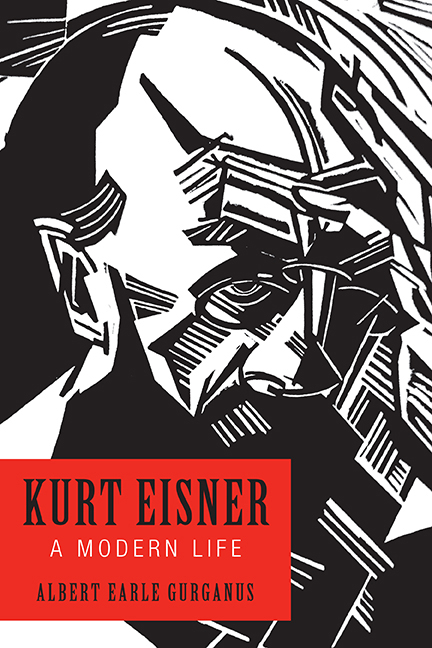Book contents
- Frontmatter
- Dedication
- Contents
- Acknowledgments
- Introduction
- 1 A Novel's Suffering Hero: A Youth in Berlin (1867–1889)
- 2 Aristocratize the Masses: From Berlin to Frankfurt to Marburg (1890–1893)
- 3 Refuge of All Idealists: Through Cohen to Kant toward Marx (1893–1896)
- 4 Dictatorial Megalomania: Lèse Majesté and Plötzensee Prison (1896–1898)
- 5 Making the Leap: Back to Berlin as a Social Democrat (1898–1900)
- 6 No Idle Dreamer: At the Helm of Vorwärts (1900–1902)
- 7 My Life's Purpose: Molding the Readership (1902–1903)
- 8 Never ... a Less Fruitful Scholastic Debate: Intramural Strife—Evolution vs. Revolution (1903–1905)
- 9 Revolutionizing Minds: The Scorched Middle Ground (1905)
- 10 The Complete Parity of My Experiences: From Exile to Nuremberg (1905–1907)
- 11 The Most Genuine and Fruitful Radicalism: Taking the Lead at the Fränkische Tagespost (1907–1908)
- 12 So Suspect a Heretic, as Surely I Am: New Bearings in North Bavaria (1908)
- 13 Dear Little Whore: Personal and Professional Turmoil (1909)
- 14 To Find a Lost Life: From Nuremberg to Munich (1909–1910)
- 15 Something of a Party Offiziosus in Bavaria: Political Editor at the Münchener Post (1910–1911)
- 16 At Peace with Myself: Resettling into Family Life (1912–1913)
- 17 The Powerlessness of Reason: The World War Erupts (1914)
- 18 Wretched Superfluity: Divided Loyalties (1915–1916)
- 19 War for War's Sake: Political Alienation and Realignment (1916–1917)
- 20 The Most Beautiful Days of My Life: Leading the Opposition (1917–1918)
- 21 Our Power to Act Now Grows: From Prisoner to Premier (1918)
- 22 The Terror of Truth: Forging the Republic, Combatting Reaction (1918)
- 23 The Fantasies of a Visionary: Martyr of the Revolution (1918–1919)
- 24 Now Dead, as It Stands: Outcomes and Legacy (1919–2017)
- Abbreviations
- Notes
- Sources and References
- Index
5 - Making the Leap: Back to Berlin as a Social Democrat (1898–1900)
Published online by Cambridge University Press: 15 August 2018
- Frontmatter
- Dedication
- Contents
- Acknowledgments
- Introduction
- 1 A Novel's Suffering Hero: A Youth in Berlin (1867–1889)
- 2 Aristocratize the Masses: From Berlin to Frankfurt to Marburg (1890–1893)
- 3 Refuge of All Idealists: Through Cohen to Kant toward Marx (1893–1896)
- 4 Dictatorial Megalomania: Lèse Majesté and Plötzensee Prison (1896–1898)
- 5 Making the Leap: Back to Berlin as a Social Democrat (1898–1900)
- 6 No Idle Dreamer: At the Helm of Vorwärts (1900–1902)
- 7 My Life's Purpose: Molding the Readership (1902–1903)
- 8 Never ... a Less Fruitful Scholastic Debate: Intramural Strife—Evolution vs. Revolution (1903–1905)
- 9 Revolutionizing Minds: The Scorched Middle Ground (1905)
- 10 The Complete Parity of My Experiences: From Exile to Nuremberg (1905–1907)
- 11 The Most Genuine and Fruitful Radicalism: Taking the Lead at the Fränkische Tagespost (1907–1908)
- 12 So Suspect a Heretic, as Surely I Am: New Bearings in North Bavaria (1908)
- 13 Dear Little Whore: Personal and Professional Turmoil (1909)
- 14 To Find a Lost Life: From Nuremberg to Munich (1909–1910)
- 15 Something of a Party Offiziosus in Bavaria: Political Editor at the Münchener Post (1910–1911)
- 16 At Peace with Myself: Resettling into Family Life (1912–1913)
- 17 The Powerlessness of Reason: The World War Erupts (1914)
- 18 Wretched Superfluity: Divided Loyalties (1915–1916)
- 19 War for War's Sake: Political Alienation and Realignment (1916–1917)
- 20 The Most Beautiful Days of My Life: Leading the Opposition (1917–1918)
- 21 Our Power to Act Now Grows: From Prisoner to Premier (1918)
- 22 The Terror of Truth: Forging the Republic, Combatting Reaction (1918)
- 23 The Fantasies of a Visionary: Martyr of the Revolution (1918–1919)
- 24 Now Dead, as It Stands: Outcomes and Legacy (1919–2017)
- Abbreviations
- Notes
- Sources and References
- Index
Summary
BACK IN MARBURG Eisner renewed contact with the Cohen circle and cast about to reestablish himself in journalism. On 20 August 1898 at Haspelstraße 37 he drafted a general letter of application in which he cited years of experience as an editor, offered to make available reviews of his work as Tat-Twam and Sperans, and listed as references—in addition to Professors Cohen, Natorp, and Rathke—Dr. Fedor Mamroth, theater critic and feuilleton editor for the Frankfurter Zeitung, and the dramatist and critic Dr. Ludwig Fulda of Berlin. In return for his services Eisner stated that he expected an annual salary in the range of 5,000 marks. Adrift, he sought to reaffirm his viewpoint in a two-part article that would not be published until the following year in Neue deutsche Rundschau (New German Review), journal of the People's Free Stage. The setting for both parts is a wineroom where three friends sit late in the evening debating the import of the fin de siècle and speculating on the shape of things to come. Eisner presents his own views in the third person, literally, for the participants are a teacher, a doctor, and “the third one, who was nothing.” Although he hardly could have anticipated it then, he framed a debate that came to rule his life for the better part of the next decade, for in their discussion the three intimates consider issues of “reforming and revolutionizing.”
The teacher at the gymnasium, a pedantic grammarian in an unhappy marriage, decries modern culture with its celebrated advances in science and technology as a dehumanizing abomination that has made mankind the subject of a perverse experiment in acceleration, extirpating all sense of tradition and community. “When we return after two years’ absence to a city where we lived, we cannot recognize it anymore: … instead of the earlier pedestrians we see bicyclists, automobiles, electric streetcars shielded from the indecent nakedness of the cloudless sky by a sieve of telephone wires….
- Type
- Chapter
- Information
- Kurt EisnerA Modern Life, pp. 67 - 88Publisher: Boydell & BrewerPrint publication year: 2018



